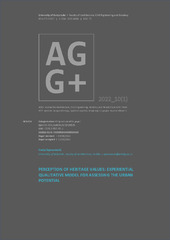Приказ основних података о документу
Perception of Heritage Values: Experiential Qualitative Model for Assessing the Urban Potential
| dc.creator | Spasenović, Vanja | |
| dc.date.accessioned | 2023-11-10T12:47:59Z | |
| dc.date.available | 2023-11-10T12:47:59Z | |
| dc.date.issued | 2022 | |
| dc.identifier.issn | 2712-0570 | |
| dc.identifier.issn | 2303-6036 | |
| dc.identifier.uri | https://raf.arh.bg.ac.rs/handle/123456789/1446 | |
| dc.description.abstract | Modern-day is defined as a period of globalization, a complex construct that can pose a threat to maintaining the uniqueness of a place and creating a distinctive city identity. The hypothesis of this paper is that, while the phenomenon of globalization is researched within different disciplines, a common interdisciplinary theme stands out - the experience and perception of urban space that further builds a unique impression of the observed scene. The assumption will be investigated through the formation of a qualitative model for examining the urban potential with the aim of affirming the visual quality of the place as an important factor in the construction of local identity. The established model is examined through case studies of the 20th-century heritage. This period was chosen because it represents the subject of a contemporary global discussion about the conservation, activation and use of heritage in urban structures. The premise is that the qualitative model can be adequately applied to architecture from this period and contribute to its visibility and understanding, as well as to the examination of its role in the creation of contemporary local identity. The research is significant because it enables an interdisciplinary consideration of heritage as a key factor in building the modern city identity based on its visual impression. | sr |
| dc.description.abstract | Савремени тренутак дефинисан је као период глобализације, сложен конструкт који може представљати опасност по неговање јединствености места и изградњу препозантљивог идентитета града. Хипотеза овог рада је да се, упркос истраживању феномена глобализације уразличитим дисциплинама, издваја заједничка интердисциплинарна тема – искуство и доживљај простора који даље гради јединствен утисак о посматраном месту. Претпоставка ће бити истражена кроз формирање квалитативног модела за испитивање урбаног потенцијала са циљем афирмисања визуелног квалитета места као значајног фактора у изградњи локалног идентитета. Постављени модел испитује се кроз студије случаја наслеђа 20. века. Овај период је изабран јер представља предмет опште дискусије на глобалном нивоу о начину конзервације, активирања и коришћења наслеђа у урбаним структурама. Претпоставка је да се квалитативни модел може адекватно применити на артефакте из овог периода и допринети њиховој видљивости и разумевању, као и испитивању њихове улоге у креирању савременог локалног идентитета. Истраживање је важно јер омогућава интердисциплинарно разматрање наслеђа као важног фактора изградње савременог идентитета места утемељеног на визуелном утиску простора. | sr |
| dc.language.iso | en | sr |
| dc.publisher | Faculty of Architecture, Civil Engineering and Geodesy and the University of Banja Luka | sr |
| dc.rights | openAccess | sr |
| dc.rights.uri | https://creativecommons.org/licenses/by/4.0/ | |
| dc.source | АGG+ Journal for Architecture, Civil Engineering, Geodesy and Related Scientific Fields | sr |
| dc.subject | visual impression | sr |
| dc.subject | identity | sr |
| dc.subject | globalization | sr |
| dc.subject | heritage | sr |
| dc.subject | spatial cognition | sr |
| dc.title | Perception of Heritage Values: Experiential Qualitative Model for Assessing the Urban Potential | sr |
| dc.type | article | sr |
| dc.rights.license | BY | sr |
| dcterms.abstract | Спасеновић, Вања; | |
| dc.citation.volume | 10 | |
| dc.citation.issue | 1 | |
| dc.citation.spage | 2 | |
| dc.citation.epage | 16 | |
| dc.identifier.doi | 10.7251/AGGPLUS/2210002S | |
| dc.identifier.fulltext | http://raf.arh.bg.ac.rs/bitstream/id/4989/bitstream_4989.pdf | |
| dc.type.version | publishedVersion | sr |

